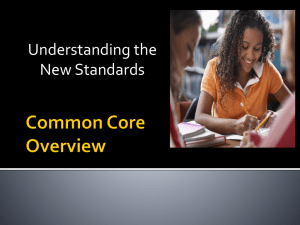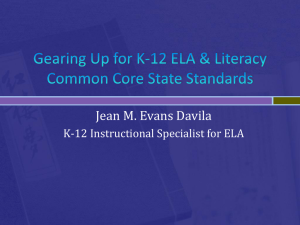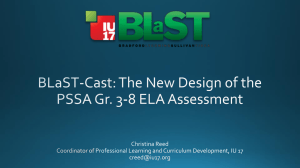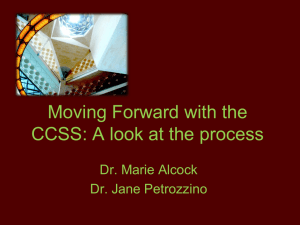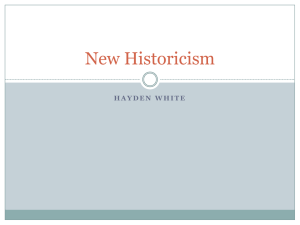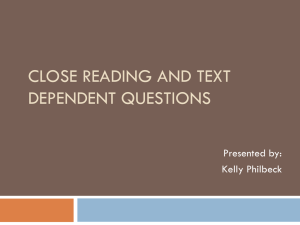Common Core Aligned Benchmark Assessment
advertisement
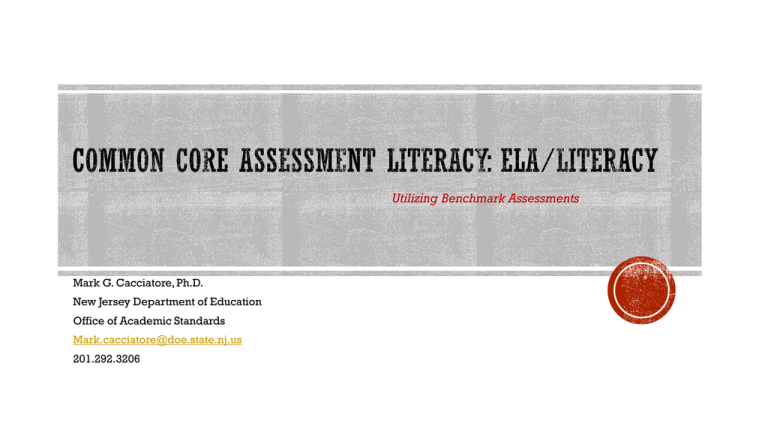
Utilizing Benchmark Assessments Mark G. Cacciatore, Ph.D. New Jersey Department of Education Office of Academic Standards Mark.cacciatore@doe.state.nj.us 201.292.3206 8:30-9:00 – Registration 9:00-11:30 – ELA/Literacy 11:30-12:30 – Lunch 12:30-2:30 – Mathematics 2:30-3:00 – Closure 2 1) What is a “balanced” assessment system? What is the role of benchmark assessments in a balanced system? 2) What do Common Core-aligned benchmark assessments look like in the following grade bands: K–2, 3–5, and 6–12? 3) What do Common Core-aligned benchmark assessments look like in social studies/history, and science and technical subjects? 4) How can I use the knowledge learned today to support my teachers’ work in creating benchmark assessments? 3 The ELA/Literacy Shifts 1. Building knowledge through content-rich nonfiction 2. Reading, writing, and speaking grounded in evidence from text, both literary and informational 3. Regular practice with complex text and its academic language Literacy in the Other Disciplines 4 Grade Literary Informational 4 50% 50% 8 45% 55% 12 30% 70% Source: National Assessment Governing Board. 2008. Reading Framework for the 2009 National Assessment of Educational Progress. Washington, DC: U.S. Government Printing Office. 5 Grade Level K–5 Opinion Informative/ Explanatory X 6–12 Argumentative Narrative X X X X X Grade To Persuade/Argue To Explain To Convey Experience 4 30% 35% 35% 8 35% 35% 30% 12 40% 40% 20% Source: National Assessment Governing Board. 2010. Writing Framework for the 2011 National Assessment of Educational Progress (Prepublication edition). Washington, DC: National Assessment Governing Board. 6 Common Core ELA/Literacy What a Balanced Assessment System Does What a Balanced Assessment System Does Not Includes evidence of student performance Overwhelm teachers with too much on challenging tasks that assess to what degree students have achieved aspects of the Common Core State Standards Provides a balance of screening, formative, benchmark, and summative assessments Involves teachers in the development and scoring of assessments…so they deeply understand and teach the standards Continuously improves teaching and data Add “another component to a teacher’s plate” Separate instruction from the assessment system process Push teachers to work in isolation learning 8 thumbs up, middle, down reading comprehension checks used to determine what level students are achieving the Common Core State Standards quizzes graphic organizers exit tickets Formative questioning 54 examples of formative assessments Benchmark PARCC End of Year/ Summative NJ ASK, HSPA 9 1.) Formative Assessment(s) Council of Chief School State Officers (2006): Formative assessment is a process; takes place during instruction. It is used not just by teachers but by both teachers and students. Helps teachers and students make adjustments that will improve students' achievement of intended curricular aims. 2.) Summative Assessment(s) Council of Chief School State Officers (2012) Intended to evaluate what students have achieved after a particular phase in their schooling — for example, after a course or a unit of study. 3.) Benchmark Assessment(s) Assessment and Accountability Comprehensive Center (2010) Administered periodically throughout the school year to evaluate students’ knowledge and skills relative to an explicit set of longer-term learning goals (Common Core State Standards) Can (and should) inform policy, instructional planning, curriculum, and decision-making at the classroom, school and/or district levels. 10 Assessment Balance 11 THOUGHTS? Formative Benchmark Summative 12 Wisconsin Department of Public Instruction (2009). Balanced Assessment System. 13 14 ELA/Literacy Sample Grade 4 Unit: Reading Informational Text Passage One: Simon, Seymour. Volcanoes. New York: HarperCollins, 2006 10 – 15 Sample Text-Dependent Questions Passage Two: National Geographic Kids: Forces of Nature: Volcanoes 101 (video) 10 – 15 Sample Text-Dependent Questions Essay: Explanatory Essay You have read two articles about volcanoes. In essay form, explain the process by which volcanoes come to explode. What causes volcanoes to explode? Please be sure to cite evidence from both texts in your writing. 15 Sample Grade 6 Unit: The Planets Passage One: Scholastic: Life on Mars 10 – 15 Sample Text-Dependent Questions Passage Two: On Mars Time, the Ice Cream Is Free 10 – 15 Sample Text-Dependent Questions Passage Three: Kidsastronomy:com: Exploring Mars 10 – 15 Sample Text-Dependent Questions Essay: Argumentative/Persuasive You have read three articles that discuss what scientists believe it would take for humans to live on Mars. In an essay, discuss whether or not you believe humans will ever successfully live on Mars. Be sure to use evidence from 2 of the 3 articles in your answer. 16 Sample Grade 10 Social Studies Unit: Great American Thinkers Part 1 Reading Passage One: Lincoln’s Second Inaugural 10 – 15 Sample Text-Dependent Questions Part 2 Reading Passage Two: MLK JR.’s Letter from Birmingham Jail 10 – 15 Sample Text-Dependent Questions Part Three Essay: Explanatory Essay You have recently read two texts by whom most consider great American thinkers and leaders. One led our country through the Civil War; the other through the Civil Rights Movement. In an essay format, explain the vision both Lincoln and King had regarding America’s future. Be sure to include textual evidence from both King and Lincoln in your writing. 17 Sample Grade 10 English Unit: Modern American Poetry Part 1 Reading Passage One: Robert Frost, Mending Wall 10 – 15 Sample Text-Dependent Questions Part 2 Reading Passage Two: Israel says Separation Wall will be border 10 – 15 Sample Text-Dependent Questions Part 3 Reading Passage Three: A Brief History of the Berlin Wall (video) 10 – 15 Sample Text-Dependent Questions Part 3 Essay: Research Simulation You have three texts that deal with the theme of “walls.” In your opinion, do you see walls as a valuable or detrimental concept? Be sure to include evidence from 2 of the 3 texts in your writing. 18 REFLECTION How aligned are my teachers’ assessments to the Common Core? Am I clear in understanding the interconnectedness of formative, benchmark, and summative assessments? Any other thoughts? 19 20 In assessment and instruction, reading, writing, and speaking and listening should never be separated. 21 The “What” of Reading Reading Areas to be Assessed The “How” of Reading The “Synthesis” of Reading 22 Important Considerations Teachers create questions as a collaborative, collegial process, using the ELA/Literacy CCSS as a guide Guide to Creating Text-Dependent Questions Try to incorporate more than one text whenever possible on the same (include multimedia) Sample Text-Dependent Questions Professional Reading: Digital Video Transforms Teaching Practices 23 Task: There are twelve sample reading items from PARCC below. Read the items carefully, and answer the following question: What is the question asking the student to do? For example, Summarizing, Inferring, Using Context Clues, Supporting Details, Main Idea, Comprehension Questions, Sequencing, Deciphering Theme, Critical Thinking, Comparison, Contrast, etc…. If you are not familiar with these literacy terms, use your own language to describe the item. Record your answers on SLIDE 39 24 25 PARCC Samples Sample 1 Sample 2 Sample 3 Sample 4 30 PARCC Samples Sample 5 Sample 6 Sample 7 Sample 8 35 PARCC Samples GRADE 9: “FIELDS OF FINGERPRINTS: DNA TESTING FOR CROPS.” Sample 9 GRADE 9: “FIELDS OF FINGERPRINTS: DNA TESTING FOR CROPS.” Sample 10 Sample 11 Sample 12 1. 2. 3. 4. 5. 6. 40 7. 8. 9. 10. 11. 12. 41 REFLECTION Are you comfortable in understanding and creating the types of reading questions aligned to the CCSS? How will you give your teachers opportunities to perform this important work in grade-level teams, department meetings, and/or PLCs? Any other thoughts? 42 43 Common Core Writing Genres Informative/Explanatory Research Simulation Prose-Constructed Response Narrative Narrative Persuasive/Argumentative Literary Analysis Research Simulation Prose-Constructed Response 44 CCSS.ELA-Literacy.CCRA.W.1 Write arguments to support claims in an analysis of substantive topics or texts using valid reasoning and relevant and sufficient evidence. PARCC Equivalent: Research Simulation Task, Literary Analysis, Prose-Constructed Response CCSS.ELA-Literacy.CCRA.W.2 Write informative/explanatory texts to examine and convey complex ideas and information clearly and accurately through the effective selection, organization, and analysis of content. PARCC Equivalent: Research Simulation Task, Prose-Constructed Response CCSS.ELA-Literacy.CCRA.W.3 Write narratives to develop real or imagined experiences or events using effective technique, well-chosen details and well-structured event sequences. PARCC Equivalent: Narrative CCSS.ELA-Literacy.CCRA.W.9 Draw evidence from literary or informational texts (including video and other digital resources) to support analysis, reflection, and research. PARCC Equivalent: Research Simulation Task, Literary Analysis, Narrative, Prose-Constructed Response 45 Literary Analysis: A writing assignment that asks students to develop an opinion, insight, or argument about two literary texts. This is the realm of the ELA teacher. Narrative: A writing assignment that asks students to continue a literary text while staying consistent with the writer’s style. In addition, students might also be asked to develop stories based upon real events (i.e. historical events, advancements in science, etc…) All content area teachers should be involved in narrative writing. Research Simulation Task: A writing assignment that asks students to synthesize two or more texts in order to advance an argument or an explanation. All content area teachers should be involved in the Research Simulation Task. Prose-Constructed Response: A writing task that asks students to summarize a literary or nonfiction text. Also, the Prose-Constructed Response may also ask students to advance an argument. All content area teachers should be involved in the Prose-Constructed Response. 46 Task: There are nine sample writing items from PARCC below. Read the items carefully, and answer the following question: What is the question asking the student to do? What do students need to know in order to successfully answer the question? Record your thoughts on Slide 60 47 48 Example of Research Simulation Task, Grades 6–8 Example of Literary Analysis, Grades 6–8 Example of Literary Analysis, Grades 10-11 Example of Prose Constructed Response, Grade 11 Both John and Abigail Adams believed strongly in freedom and independence. However, their letters suggest that each of them understood these terms differently based on their experiences. Write an essay that explains their contrasting views on the concepts of freedom and independence. In your essay, make a claim about the idea of freedom and independence and how John and Abigail Adams add to that understanding and/or illustrate a misunderstanding of freedom and independence. Support your response with textual evidence and inferences drawn from all three sources. 52 53 Example of Research Simulation Task, Grade 3 ELIZA’S CHERRY TREES: JAPAN’S GIFT TO AMERICA THE PEANUT MAN You have read two texts about famous people in American history who solved a problem by working to make a change. Write an article for your school newspaper describing how Eliza and Carver faced challenges to change something in America. In your article, be sure to describe in detail why some solutions they tried worked and others did not work. Tell how the challenges each one faced were the same and how they were different. Example of Literary Analysis, Grades 3–5 Example of Literary Analysis, Grade 4 KIRA-KIRA Example of Prose-Constructed Response Read the “Biography of Amelia Earhart” 58 Example of Narrative Writing Task, Grade 6 Excerpt of Julie of the Wolves Appendix C 60 Persuasive/Argumentative Informative/Explanatory Narrative 61 ELA/Literacy 1) Choose an appropriately leveled complex text. Remember, you are encouraged to pair texts together, and starting at the middle school, you can and should introduce three texts. The terms “text” also includes digital images, videos, and other forms of multimedia. 2) Align the text(s) to one of the Common Core writings tasks: persuasive/argumentative, informative/explanatory, or narrative. Use the grade-level Common Core standard in writing to develop the writing task. The three genres of writing increase in difficulty as students progress through school. For example, if you are creating an argumentative essay using an excerpt from the 11th grade nonfiction book1776 by David McCullough, then be sure to use the 11th grade ELA/Literacy argumentative standards. 3) Create text-dependent questions for the texts you have chosen. Be sure to align the textdependent questions with the full range of reading tasks for that particular grade level. For example, if you using a 4th to 5th text (such as “Discovering Mars: The Amazing Story of the Red Planet”), then be sure to use the Reading Informational CCSS ELA standards for the 4th or 5th grade to create your questions. 63 Vertical Alignment Writing Vertical Alignment Reading Literature Vertical Alignment Reading Informational Text 64 Grade Use of DRA to Benchmark Reading Progress Literary Analysis Narrative Informative / Explanatory Opinion K Yes Giovanni, Nikki. “Covers.” (Fiction; poetry) Eastman, P. D. Are You My Mother? (Fiction; story) Aliki. My Five Senses. (Informational Text) The Best Pet: Cats or Dogs? 1 Yes Chute, Marchette. “Drinking Fountain.” (Fiction; poetry) Minarik, Else Holmelund. Little Bear. (Fiction; story) Hurd, Edith Thacher. Starfish. (Informational Text) Floca, Brian. Moonshot: The Flight of Apollo 11 (Informational Text) 2 Yes Jarrell, Randall. “A Bat Is Born.” (Fiction; poetry) Averill, Esther. The Fire Cat (Fiction; story) Kudlinski, Kathleen V. Boy, Were We Wrong About Dinosaurs. (Informational Text) National Geographic: Prehistoric World: Dinosaurs 101 (Informational Text, Video) Speaking & Listening Language Reading Component Use CCSS Reading Literature Standards to create “textdependent” reading comprehension questions Gibbons, Gail. Fire! Fire! (Information text) Fire! Fire! (video) Reading Component Use CCSS Reading Informational Text Standards to create “text-dependent reading comprehension questions Written Component Use appropriate grade-level writing standards to create a writing assessment based upon identified texts and genre 65 66 67 Grade Use of DRA to Benchmark Reading Progress Literary Analysis Narrative Information/Explanatory Opinion 3 Yes Soto, Gary. “Eating While Reading.” (Fiction; poetry) Osborne, Mary Pope. The OneEyed Giant (Book One of Tales from the Odyssey) (Fiction; story) Beeler, Selby. Throw Your Tooth on the Roof: Tooth Traditions Around the World. (Informational Text) Why Cats Make Better Pets than Dogs (Informational Text) Williams, Carlos, Williams. “This is Just to Say.” (Fiction; poetry) 4 Yes Thayer, Ernest Lawrence. “Casey at the Bat.” (Fiction; poetry) At what age do children start losing their baby teeth? (Informational Text) Curtis, Christopher Paul. Bud, Not Buddy. (Fiction; novel) Rice, Grantland. “Casey’s Revenge” (Fiction; poetry) 5 Yes Blake, William. “The Tiger.” (Fiction; poetry) Language Berger, Melvin. Discovering Mars: The Amazing Story of the Red Planet. (Informational Text) Evidence Of Water on Mars (Informational Text; video) Carroll, Lewis. Alice’s Adventures in Wonderland. (Fiction; novel) Blake, William. “The Lamb” (Fiction; poetry) Speaking & Listening Why Dogs Make Good Pets (Informational Text) Reading Component Use CCSS Reading Literature Standards to create “textdependent” reading comprehension questions Lauber, Patricia. Hurricanes: Earth’s Mightiest Storms. (Informational Text) NASA: How are Hurricanes Created? (Informational Text & video) Are Sports Stars Heroes? (Informational Text) 10 Sports Heroes That Are Actually Heroes (Informational Text; slideshow of images and text) “Antarctica Breaking” (Informational Text) Global Warming: Global Warming 101 (Informational Text; video) Reading Component Use CCSS Reading Informational Text Standards to create “textdependent reading comprehension questions Written Component Use appropriate grade-level writing standards to create a writing assessment based upon identified texts and genre 68 Grade 8 Literary Analysis Narrative ELA Whitman, Walt. “O Captain! My Captain!” Fiction: Cisneros, Sandra. “Eleven.” Whitman, Walt. “When Lilacs Last in the Dooryard Bloom’d” Argumentative Informative / Explanatory Chew on This by Eric Schlosser and Charles Wilson Douglass, Frederick. Narrative of the Life of Frederick Douglass an American Slave, Written by Himself. Healthy Fast Food Tips for Making Healthier Fast Food Choices Frederick Douglass Biography Chick-fil-A Commits to Stop Sales of Poultry Raised With Antibiotics History Science / Technical Subjects X X Nonfiction: Freedman, Russell. Freedom Walkers: The Story of the Montgomery Bus Boycott. United States. Preamble and First Amendment to the United States Constitution. Churchill, Winston. “Blood, Toil, Tears and Sweat”: Address to Parliament on May 13th, 1940 Monk, Linda R. “Words We Live By: Your Annotated Guide to the Constitution.” FDR’s “Day of Infamy” Speech Exploring space: Why’s it so important? Greenberg, Jan, and Sandra Jordan. Vincent Van Gogh: Portrait of an Artist. New York: Random House, 2001. (2001) From Chapter 1: “A Brabant Boy 1853–75” Mackay, Donald. The Building of Manhattan Mars can wait. Oceans can't Biography.com: Vincent Van Gogh (video) Written Assessments Paired with Complex Text (Standard 10) 69 Grade 11 Literary Analysis ELA Shakespeare Sonnet 19 Narrative Argumentative Informative / Explanatory The Great Gatsby Miller, Arthur. Death of a Salesman Orwell, George. “Politics and the English Language.” Shakespeare Sonnet 29 Former President Bill Clinton says American dream is under assault History N/A Declaration of Sentiments by the Seneca Falls Conference Science / Technical Subjects McCullough, David. 1776 (excerpt) The Man Who Would Not Be King Douglass, Frederick. “What to the Slave Is the Fourth of July?” The Accomplishments of President Abraham Lincoln Frederick Douglas Biography.com (video) N/A Tyson, Neil deGrasse. “Gravity in Reverse: The Tale of Albert Einstein’s ‘Greatest Blunder.’ Kurzweil, Ray. “The Coming Merger of Mind and Machine.” Nine Jobs that Humans May Lose to Robots A Guide to Statistics on Historical Trends in Income Inequality Inequality in America: The Data Is Sobering Advancements in robotics provide safety in battle and at home Written Assessments Paired with Complex Text (Standard 10) 70 Data Analysis PLCs, Departmental, Grade-Level Meetings Themes/Patterns Impact on Instruction 71 REFLECTION Are you comfortable in understanding and creating the types of writing assessments aligned to the CCSS? How can we ensure that teachers perform this important work in grade-level teams, department meetings, and/or PLCs? Any other thoughts? 72 Mark G. Cacciatore, Ph.D. New Jersey Department of Education Office of Academic Standards Mark.cacciatore@doe.state.nj.us 201.292.3206 73 https://www.surveymonkey.com/s/AssessmentLiteracy4-10-14 74 Council of Chief State School Officers (CCSSO) (2006). Attributes of Effective Formative Assessment. Retrieved from http://www.ccsso.org/Resources/Publications/Attributes_of_Effective_Formative_Assessment.html CCSSO (2012). Distinguishing Formative Assessment from other Educational Assessment Labels. Retrieved from http://www.ccsso.org/Documents/FASTLabels.pdf Herman, J. L., Osmundson, E., & Dietel, R. (2010). Benchmark assessments for improved learning (AACC Policy Brief). Retrieved from http://www.cse.ucla.edu/products/policy/R1_benchmark_polbrief_Herman.pdf Wees, D. (2013). 54 different examples of formative assessment. Retrieved from https://docs.google.com/presentation/d/1nzhdnyMQmio5lNT75ITB45rHyLISHEEHZlHTWJRqLmQ/pub?start=false&loop=false&delayms=3000#slide=id. p Wisconsin Department of Public Instruction (2009). Balanced Assessment System. Retrieved from http://oea.dpi.wi.gov/files/oea/pdf/bas.pdf Wisconsin Department of Public (2010). Balanced Assessment System by Type. Retrieved from http://dpi.wi.gov/files/oea/pdf/balsystem.pdf 75 Common Core ELA/Literacy Appendices B & C: http://www.corestandards.org/ela-literacy Engage: New York State Education Department: http://www.engageny.org/english-language-arts Student Achievement Partners (Achievethecore): Common Core Argument/Opinion Writing: http://www.achievethecore.org/page/503/common-core-argument-opinion-writing Student Achievement Partners (Achievethecore): Common Core Informative/Explanatory Writing: http://www.achievethecore.org/page/504/common-core-informative-explanatory-writing Student Achievement Partners (Achievethecore): Common Core Narrative Writing: http://www.achievethecore.org/page/505/common-core-narrative-writing 76

